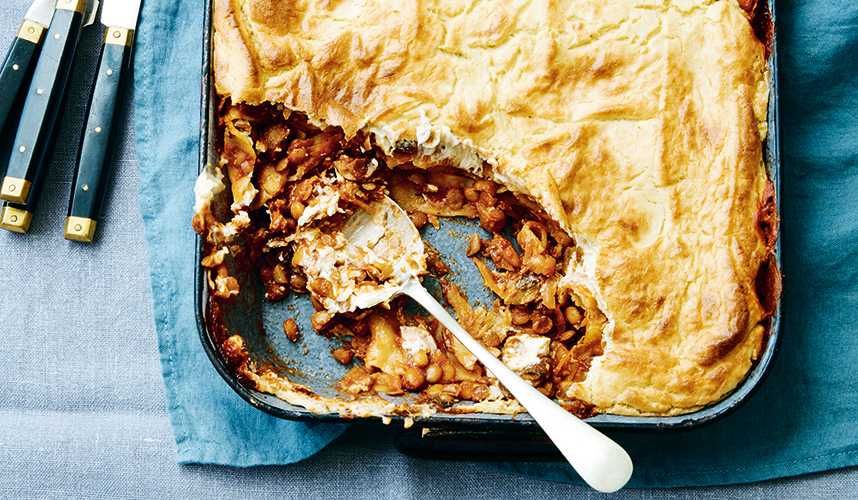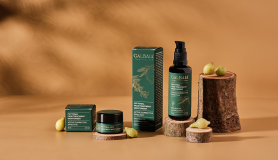My biggest inspiration for my recipes are seasonal and organic produce. I love cooking with vegetables, grains, fruits, beans, seeds, herbs and spices. My style of cooking is all about flavour, colour and fun. All my recipes are vegan, refined sugar free and low fat. During my life I have experimented with all kinds of diets and cooking techniques, think: raw food, vegan, macrobiotic, vegetarian, gluten free, high starch/ low fat, etc. All these different styles have made me the cook that I am today. Here are some of my favourites for a winter feast.
Lasagne with lentil ragout and cauliflower béchamel
Lasagne is a crowd-pleasing dish with its comforting flavours. It’s perfect for when guests are coming – you can prepare the lasagne ahead of time and pop it in the oven when they arrive. I swapped the traditional meat-based sauce for a lentil and tomato ragoût and the milk-based béchamel for a creamy cashew sauce.
SERVES 6
• 250g dried lasagne sheets of your choice (spelt, wholegrain, gluten-free)
FOR THE LENTIL RAGOÛT
- 2 carrots, grated
- 1 onion, finely diced
- 250g mushrooms, roughly chopped
- 1 courgette, grated
- 5 garlic cloves, chopped
- 1/2 teaspoon chilli powder (or more, to taste)
- 700ml tomato passata
- 1 tablespoon mushroom powder
- 1 tablespoon maple syrup (optional)
- 500g (drained weight) cooked, lentils (either homemade or from two 400g cans)
- 2 teaspoons dried oregano
- 1 bunch of fresh basil, roughly chopped
- 300ml vegetable stock or watersalt, to taste
FOR THE BÉCHAMEL
- 400g cauliflower florets
- 200g cashews, soaked and drained
- 200ml vegetable stock or hot water
- 3 tablespoons nutritional yeast
- ¼ -1/2 teaspoon freshly grated nutmeg (to taste)
- Salt
- Preheat the oven to 180C/gas mark 4.
- To make the ragoût, heat a large non-stick frying pan and add the carrots, onion, mushrooms and courgette. Water fry them with 2 tablespoons of water or stock. Sauté until the vegetables are soft and translucent (this will take about 8–10 minutes). Then stir in the garlic and chilli, and cook for a further 2 minutes. Now add the passata, mushroom powder, maple syrup, lentils, oregano, basil, vegetable stock and salt to taste. Bring to the boil, then simmer over a low heat for about 15–20 minutes.
- Meanwhile, make the béchamel. Start by adding the cauliflower florets to a pan of boiling water and cook until they are soft (they are done when you can easily pierce one with a sharp knife). Drain the florets and transfer to a blender. Add the soaked cashews, vegetable stock, nutritional yeast, salt and nutmeg. Blend until completely smooth. Set aside.
- When the ragoût is ready you can assemble your lasagne. Take a large deep-sided ovenproof dish (mine is 20 x 30cm) and spread a little ragout over the base. Form a layer of lasagne sheets then a layer of ragoût. Continue to layer the lasagne sheets and ragout until the dish is almost full and you have used up all the ragout.
- Top the lasagne with the bechamel and transfer the dish to the middle of your oven. Cook for 45 minutes then remove from the oven. Let it sit for 10 minutes before serving.
Savoury beetroot muffins
Cake salé (‘salty cake’) is not part of Dutch cuisine. I was introduced to it by a French friend and I really wanted to make my own savoury cake. The key feature of the cake is that it’s light in texture. Normal cakes include eggs to accomplish this, but here aquafaba gives these hearty muffins a nice airy touch. Beetroot is naturally a bit sweet so these savoury muffins benefit from the contrast provided by the salty olives. All in all, I think I’ve succeeded in my mission to make a vegan cake salé.
MAKES 10-12 MUFFINS
- 70g pumpkin seeds
- 1 and ½ raw medium red beetroots, peeled
- 6 tablespoons aquafaba (chickpea cooking liquid), chilled
- 200g wholegrain spelt flour
- 50g oat flakes
- 2 teaspoons baking powder
- 1 teaspoon bicarbonate of soda
- 2 tablespoons nutritional yeast (optional)
- 1 teaspoon each salt and ground black pepper
- 300ml natural plant-based yogurt
- small bunch of chives, finely chopped
- 2 tablespoons freshly chopped thyme
- 70g pitted black olives, chopped
- Preheat the oven to 200C/gas mark 6. Heat a cast-iron or non-stick pan and dry-roast the pumpkin seeds until they start to pop. Set aside.
- Finely grate the beetroot using a food-processor, mandoline or box grater. Set aside.
- Whip the aquafaba in a clean bowl using handheld electric beaters or a stand mixer until stiff white peaks form.
- In another bowl mix the flour, oat flakes, baking powder, bicarbonate of soda, nutritional yeast (if using), salt and pepper.
- In a blender mix together the yogurt and beetroot until combined. Add this to the flour mixture, along with the herbs, chopped olives and whipped aquafaba. Mix gently until all the ingredients have been combined.
- Line a muffin tray with paper cases and divide the mixture evenly between them. You can use an ice-cream scoop to make the muffins the same size. Scatter over the pumpkin seeds. Bake in the oven for 20–25 minutes. When a wooden cocktail stick inserted into a muffin comes out clean, the muffins are cooked. Remove from the oven and leave them to cool.
- Once cooked, you’ll notice that their vibrant pink colour has faded – this is normal.
New potato salad with radishes and peas
Over the past few years it has seemed that the potato has become less popular as a staple in comparison with more exotic options like rice or noodles. In Holland the potato was once an essential everyday ingredient. Cooked potatoes were served almost every day with another vegetable (like cauliflower) and a piece of meat at six o’clock precisely. In my home we mashed the two vegetables together on our plate and poured the gravy from the meat over the top. In the old days, if you were very poor you ate only potatoes. Take a look at Vincent van Gogh’s famous painting ‘The Potato Eaters’. Also one of the most famous varieties of potatoes – ‘Bintje’ – comes from The Netherlands. Nowadays people no longer see the beauty of this ingredient, which is a shame. The potato is nourishing and gentle on the digestive system. The arrival of new potatoes always excites me and the recipe for this salad is a beautiful example of how good a potato can be.
SERVES 4 AS A MAIN OR 6 AS A STARTER
TIP: This salad is good served with pickled onions on the side.
- 750g baby potatoes, halved (larger ones quartered)
- 250g peas, defrosted if frozen
- 300ml natural plant-based yogurt or Cashew Soured Cream
- 2 teaspoons mustard, such as Dijon
- 1 tablespoon raw apple cider vinegar or lemon juice
- small bunch of chives, finely chopped
- small bunch of flat-leaf parsley, finely chopped
- 1–2 garlic cloves, finely chopped (optional)
- small bunch of radishes, sliced
- salt and pepper
- Put the potatoes in a pan, cover with cold water and bring to the boil. Cook the potatoes until they are just done, but not overcooked – about 5–7 minutes. The potatoes are done if they can be easily pierced with a sharp-pointed knife. In the last minute of cooking time add the peas. Drain the potatoes and peas in a colander and set them aside while making the sauce for your potato salad.
- In a large bowl combine the yogurt or cashew cream, mustard, vinegar or lemon juice, herbs and garlic and add salt and pepper to taste. Tip in the potatoes, peas and radishes. Gently combine everything until all the potatoes are covered with sauce. Mix gently – you don’t want to break up the potatoes too much. Serve immediately or place in the fridge until ready to serve.
Apple cinnamon cake with chai drizzle
The smell of a warm apple tart with cinnamon just instantly brings me back to my childhood at my grandparents’ house. On autumn weekends my grandfather would make a tart using the apples from his allotment which he so carefully maintained. I watched him making the cake and although this vegan version is completely different, I know he will like it.
SERVES 8-10
FOR THE CAKE
FOR THE CHAI DRIZZLE
Rita is a food blogger and author of several books about veganism. She lives between The Netherlands and France with her husband and daughter
- 6 tbsp chilled aquafaba (chickpea cooking water)
- 250g wholegrain spelt flour (or use gluten-free flour)
- 1 ½ tsp baking powder
- 1 ½ tsp bicarbonate of soda
- 2 ½ tsp ground cinnamon
- 175g coconut sugar
- 180ml natural plant-based yogurt
- pinch of salt
- 2 medium apples, coarsely grated
- 5 tbsp raw white cashew butter (or white almond butter)
- 60ml maple syrup
- 1 teaspoon vanilla powder
- 1 ½ tsp ground cinnamon
- ½ tsp freshly grated nutmeg
- seeds from 1 cardamom pod
- small pinch of black pepper
- 1 ½ tsp freshly grated ginger
- pinch of salt
- Preheat the oven to 180C/gas mark 4. Line the base of a 20cm springform tin with baking paper.
- Whisk the aquafaba in a clean bowl until stiff white peaks form. Set aside.
- Sift the flour into a separate bowl and add the baking powder, bicarbonate of soda, cinnamon, coconut sugar and salt. Mix the ingredients and gently mix in the yogurt, whipped aquafaba and grated apple. Transfer this mixture to the cake tin. Bake for 50–60 minutes. Check if it is ready by inserting a skewer into the centre of the cake. If it comes out clean, the cake is done; if any mixture clings to the skewer, cook the cake for an additional 5 minutes and try again. Remove the cake from the oven and allow to cool a little in the tin before turning out and transferring to a wire rack to cool completely.
- Meanwhile, make your drizzle by mixing all the ingredients in a blender. You may need to add a little nut milk, a tablespoon at a time, to thin. Be careful though: the more liquid you add, the runnier your drizzle will become. Once the cake has cooled completely, pour over the chai drizzle.
MORE INSPIRATION
READ Vegan for Good by Rita Serano. (Kyle Books). Photography by Clare Winfield
FIND Plenty of recipe inspiration at ritaserano.com







